ORDER
Charadriiformes
FAMILY
Laridae
GENUS & SPECIES
KEY FEATURES
• Reaches sexual maturity at 6-8 years of age, later than any other member of the gull family
• Easily distinguished from other terns by its two-tone plumage: black above, white below
• Breeding cycle seems to follow the phases of the moon in the south Atlantic
WHERE IN THE WORLD?
Found in tropical and subtropical regions of the Indian, Pacific and Atlantic Oceans, including Africa, Australia and North America

Lifecycle
The sooty tern rides the air currents of the world’s oceans, mating regardless of the season and taking the longest time to mature of any gull or tern.
Habitat
Strong fliers, sooty terns travel in large flocks high above the ocean surface throughout the year Thousands of birds fly in tight formations across the
Pacific, Indian and Atlantic Oceans in search of surface fish and squid. Rarely settling on the sea itself, the sooty terns rest instead on tiny islands, sandbars and floating debris. All year-round, millions of sooty terns come ashore to breed on tropical and subtropical islands in all three oceans, including the Bahamas, the West Indies, Hawaii and the Galapagos Islands. Occasionally, cyclones and hurricanes force the birds to land far from their intended destinations. The sooty tern nests on any surface, whether sand, coral or rock, as long as fish and squid are nearby.The terns lay their eggs on the bare ground and carefully protect them from predators and the harsh heat.
Natural shade A sooty tern incubates its one egg on the sandy beach and attempts to shade it from the intense tropical heat.
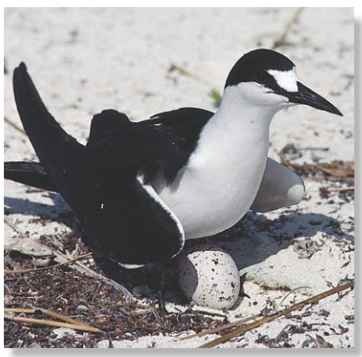
food & hunting
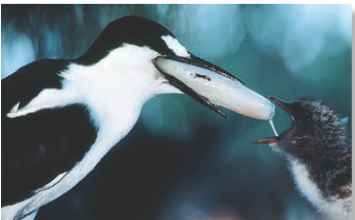
A Down torpedo A parent returns from a long feeding excursion at sea with a squid for its anxiously awaiting chick.
The sooty tern, with its elegant black-and-white plumage, soars gracefully above the tropical seas. It looks for schools of large, predatory fish chasing smaller squid and fish, including the goatfish, mackerel scad and flying fish, which rush to the surface in an attempt to escape their aquatic predators. When the fish or squid surface, the sooty tern swoops down and plucks a meal from the water Sometimes, the small fish even jump out of the water to avoid the predators, and the sooty tern easily picks them off in midair The bird prefers not to swim or dive in pursuit of food, since its feathers are not entirely waterproof.Therefore, the sooty tern also feeds at dawn and dusk, when squid and deep-sea fish rise to the surface to feed.Then the tern easily snatches them from the surface.
The sooty tern eats fish that are pursued by tuna. Fishermen follow terns to tuna schools.
Distinct flocks have totally different breeding cycles. On Manana Island in the Pacific, a flock breeds in April, but 10 miles away on Moko Manu, in October.
conservation
The sooty tern population probably exceeds 25 million pairs; it is not currently threatened. One of the most numerous seabirds, its highest numbers are in the South Pacific. However, some island colonies suffer losses from predators, especially cats and humans.
Breeding
Throughout the breeding season, the sooty tern participates in “parades,” common breeding displays that consist of the two mated birds circling each other. They droop their wings, arch their neck and take small running steps. The nest is no more than a shallow scrape or depression in the sand, soil, coral or rocks. The female lays one pale or buff egg with brown splotches. Both parents take turns incubating and relieve each other frequently, since the tropical heat is so intense. After hatching, the parents shade the chick with their wings, but the stints in the hot sun dehydrate the adults. They often fly off and dip their feet in the water to cool off. The young grow rapidly and fledge in two months. Most sooty terns take from 6-8 years to mature, the longest of any tern or gull. Though most breed yearly, those near the equator; including Ascension Island in the mid-Atlantic, breed every 9-10 months, seemingly following the phases of the moon.
a tern’s terms
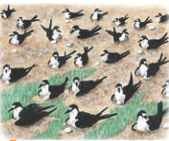
Overtime…
Sooty terns nest in large colonies beneath the hot tropical sun and try to shield each of their lone eggs from the intense heat.
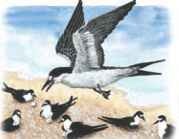
Overhead…
Each parent goes out to sea in search of its own food, to keep its energy up, before returning to incubate the eggs.

Overheat…
A tern opens its wings to shield its chick from the hot midday sun. It sacrifices its own comfort for the well-being of its chick.
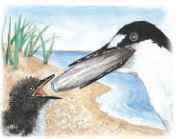
Overeat
As the chick grows, both parents leave to find food. One parent offers an entire squid to its ravenous chick.
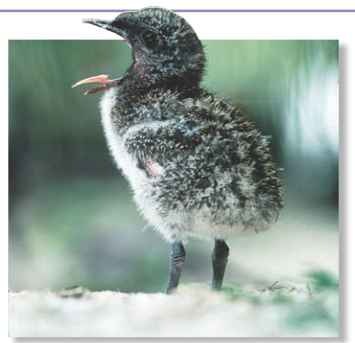
Behavior
When other seabirds have settled forthe night, the sooty tern’s flight call, ker-wacky-wack, continues to carry far across the sea. Sailors say it sounds like “wide awake.” The sooty tern often feeds at dusk when squid, a staple of its diet, surface at night.The breeding tern eats enough for two and brings back a bedtime snack forthe young chick.The sooty terns nest close together even when more space is available. With neighbors so near, there is often pecking and bickering between adults, and even adults and the young of adjacent pairs. But the terns fiercely defend their colony with aerial attacks on intruders.
Sharp “V” During a mating display, a tern swings both wings to strike an impressive pose.

Profile
Sooty Tern
Strong and graceful in flight, the sooty tern is awkward on land and a reluctant swimmer — its plumage is not completely waterproof.
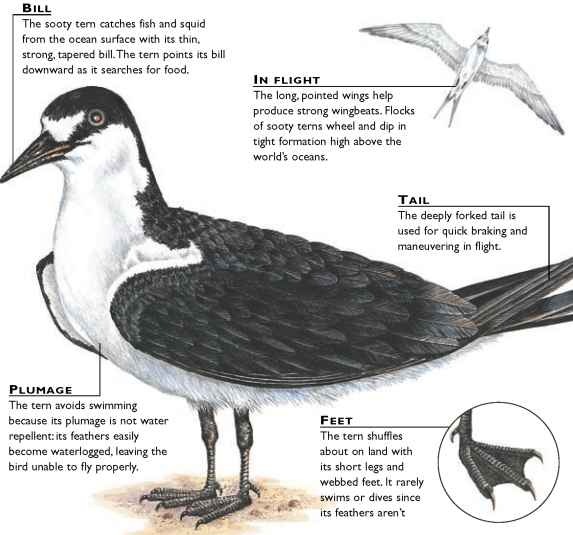
Creature comparisons
Measuring up to 19″ in length, the greater crested tern (Thalasseus bergii) is the third largest tern. With a wingspan of 41″, it is slightly larger than its close relative, the sooty tern.The greater crested tern’s white and gray coloration is interrupted by its long-crested black cap and yellow bill, whereas the sooty tern’s white forehead stands out against its black upperparts and bill. Unlike the widespread sooty tern, the greater crested tern is found only in the Indian and Pacific Oceans, with approximately 500,000 pairs in Australia and about 50,000 pairs elsewhere.
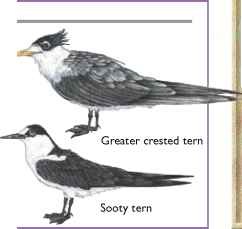
| VITAL STATISTICS | |
| Weight | 5-8.25 oz. |
| Length | 15-18″ |
| Wingspan | 34-35″ |
| Sexual Maturity | 4-8 years |
| Breeding Season | Varies according to region |
| Number of Eggs | |
| Incubation Period | 28-30 days |
| Fledging Period | 56-63 days |
| Breeding Interval | 9-12 months |
| Typical Diet | Small fish and invertebrates, mainly squid |
| Lifespan | Up to 33 years |
RELATED SPECIES
• The sooty tern joins about 24 other species of tern in the genus Sterna. i The genus Hydroprogne includes the Caspian tern, H. caspia, the largest tern. Over 35 total species of tern are members of the Laridae family. The family consists of about 82 species of gulls, kittiwakes, terns and noddies. These birds are joined by puffins, plovers, sandpipers and sheathbills in the order Charadriiformes.

